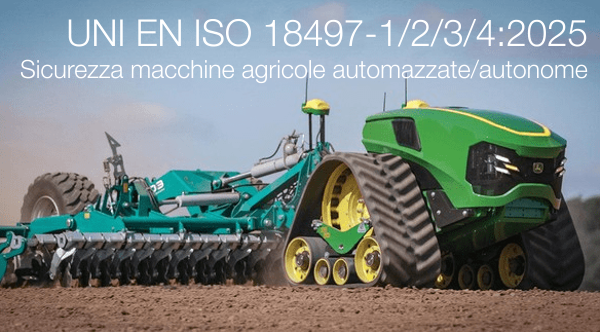UNI EN ISO 18497-1/2/3/4:2025

Norme UNI EN ISO 18497-1/2/3/4:2025 - Sicurezza macchine agricole trattrici automatizzate / autonome
ID 24183 | 27.06.2025 / Preview allegati
ID 16403 | 15.04.2022 / In allegato preview
UNI EN 280-1:2022 Piattaforme di lavoro mobili elevabili - Parte 1: Calcoli per la progettazione - Criteri di stabilità - Costruzione - Sicurezza - Esami e prove
Recepisce: EN 280-1:2022
Data entrata in vigore: 14 aprile 2022
La norma specifica i requisiti e le misure di sicurezza per tutti i tipi e le dimensioni di piattaforme di lavoro mobili elevabili (MEWP), destinate a spostare persone alle posizioni di lavoro in cui svolgono mansioni dalla piattaforma di lavoro (WP), con l'intenzione che le persone accedano ed escano dalla piattaforma di lavoro solo in posizioni di accesso a livello del suolo o sul telaio.
Sostituisce: UNI EN 280:2015
In allegato Preview EN 280-1:2022
_______
EN 280-1:2022 Mobile elevating work platforms - Part 1: Design calculations - Stability criteria - Construction - Safety - Examinations and tests
This document is a type C standard as stated in EN ISO 12100:2010.
The machinery concerned and the extent to which hazards, hazardous situations and hazardous events are covered are indicated in the scope of this document.
When provisions of this type C standard are different from those which are stated in type A or B standards, the provisions of this type C standard take precedence over the provisions of the other standards, for machines that have been designed and built according to the provisions of this type C standard.
The object of this document is to define rules for safeguarding persons and objects against the risk of accidents associated with the operation of Mobile Elevating Work Platforms (MEWPs).
- This document does not repeat all the general technical rules applicable to every electrical, mechanical or structural component.
- The safety requirements of this document have been drawn up on the basis that MEWPs are periodically maintained according to manufacturers' instructions, working conditions, frequency of use and national regulations.
It is assumed that MEWPs are used only by qualified and trained operators.
It is also assumed that MEWPs are checked for function daily by the operator before start of work and are not put into operation unless all required control and safety devices/functions are available and in working order.
If a MEWP is seldom used, the checks may be made before start of work.
- As far as possible this document sets out only the requirements that materials and equipment need to meet in the interest of safety, and it is assumed that persons operating MEWPs are adequately trained.
- Where for clarity an example of a safety measure is given in the text, this does not need to be considered as the only possible solution. Any other solution leading to the same risk reduction is permissible if an equivalent level of safety is achieved.
- As no satisfactory explanation could be found for the dynamic factors used for stability calculations in previous national standards, the results of the tests carried out by the former CEN/TC 98/WG 1 to determine a suitable factor and stability calculation method for MEWPs have been adopted. The test method is described in Annex C (informative) as a guide for manufacturers wishing to use higher or lower operating speeds and to take advantage of developments in control systems.
Similarly, to avoid the unexplained inconsistencies in coefficients of utilization for wire ropes found in other standards for lifting devices, appropriate extracts of the widely accepted standard DIN 15020-1 have been taken into 4.5.2 and Annex D (normative) with a worked example in Annex E (informative).
This document may also be used as guidance for static elevating work platforms where the vertical projection of the centre of the area of the platform can be outside the tipping lines.
1 Scope
1.1 This document specifies safety requirements and measures for all types and sizes of Mobile Elevating Work Platform (MEWP, see 3.1) intended to move persons to working positions where they are carrying out work from the work platform (WP) with the intention that persons are getting on and off the work platform only at access positions at ground level or on the chassis.
NOTE Machines designed for the handling of goods which are equipped with work platforms as interchangeable equipment are regarded as MEWPs.
1.2 This document is applicable to the structural design calculations and stability criteria, construction, safety examinations and tests before MEWPs are first put into service. It identifies the hazards arising from the use of MEWPs and describes methods for the elimination or reduction of these hazards.
It does not cover the hazards arising from:
a) use in potentially explosive atmospheres;
b) work from the platform on external live electric systems;
c) use of compressed gases for load bearing components;
d) getting on and off the work platform at changing levels;
e) specific applications (e.g. railway, ships) covered by National or local regulations.
1.3 This document does not apply to:
a) machinery serving fixed landings (see e.g. EN 81-20:2020 and EN 81-50:2020, EN 12159:2012);
b) fire-fighting and fire rescue appliances (see e.g. EN 1777:2010);
c) unguided work cages suspended from lifting appliances (see e.g. EN 1808:2015);
d) elevating operator position on rail dependent storage and retrieval equipment (see EN 528:2021);
e) tail lifts (see EN 1756-1:2021 and EN 1756-2:2004+A1:2009);
f) mast climbing work platforms (see EN 1495:1997+A2:2009);
g) fairground equipment;
h) lifting tables (see EN 1570-1:2011+A1:2014 and EN 1570-2:2016);
i) aircraft ground support equipment (see e.g. EN 1915-1:2013 and EN 1915-2:2001+A1:2009);
j) elevating operator positions on industrial trucks (see EN ISO 3691-3:2016).
...
Fonte: UNI
Collegati

ID 24183 | 27.06.2025 / Preview allegati

Comunicazione della Commissione nell’ambito dell’applicazione della direttiva 93/42/CEE del Consiglio, del 14 giugno 1993, concernente i disp...

Update 01 Febbraio 2019
Pubblicata dal CEI la Variante 5 (V5)
Questa Variante contiene la nuova Sezione 443 della Norma CEI 64-8/4, la nuova Sezione 534 d...
Testata editoriale iscritta al n. 22/2024 del registro periodici della cancelleria del Tribunale di Perugia in data 19.11.2024